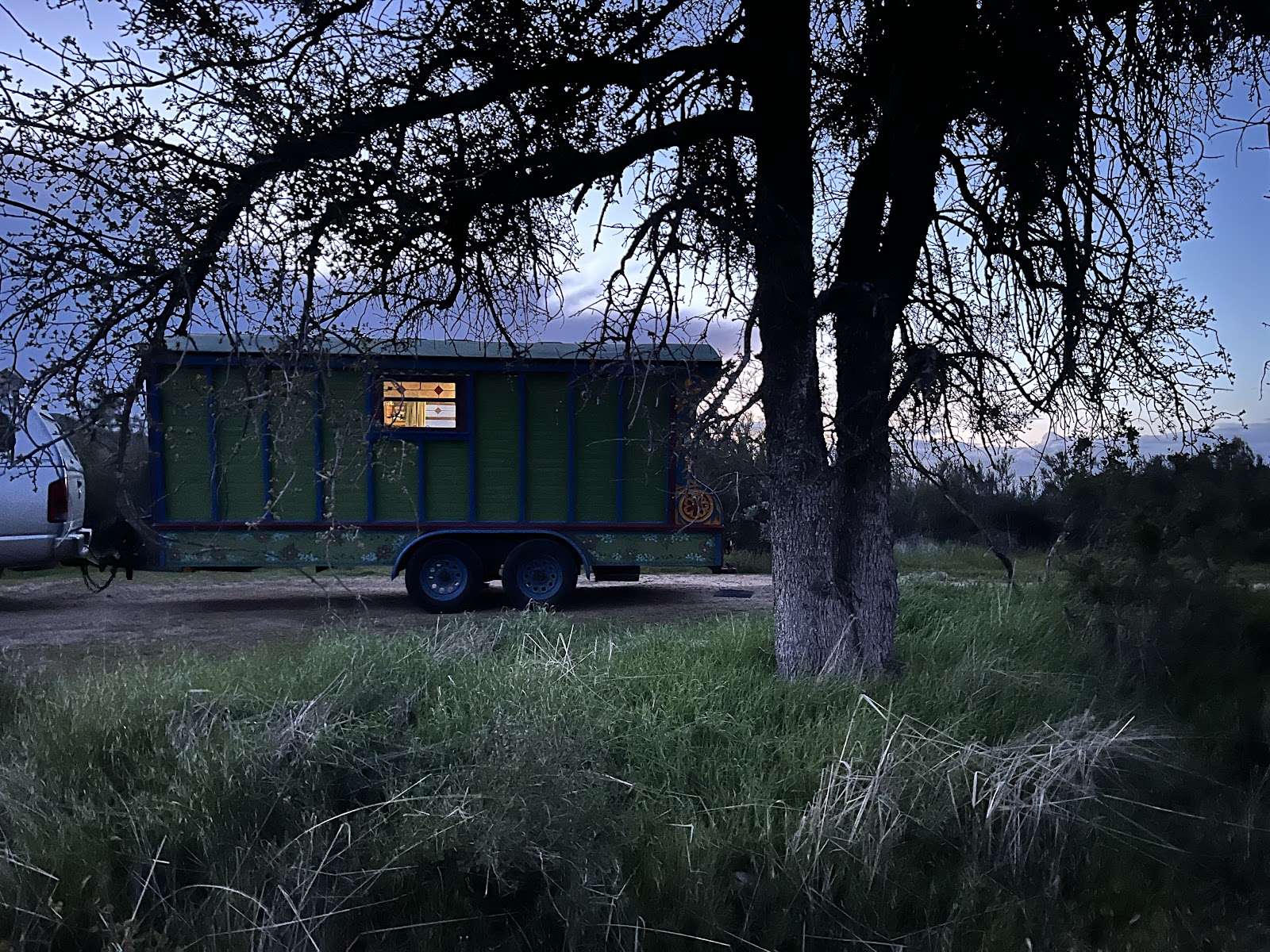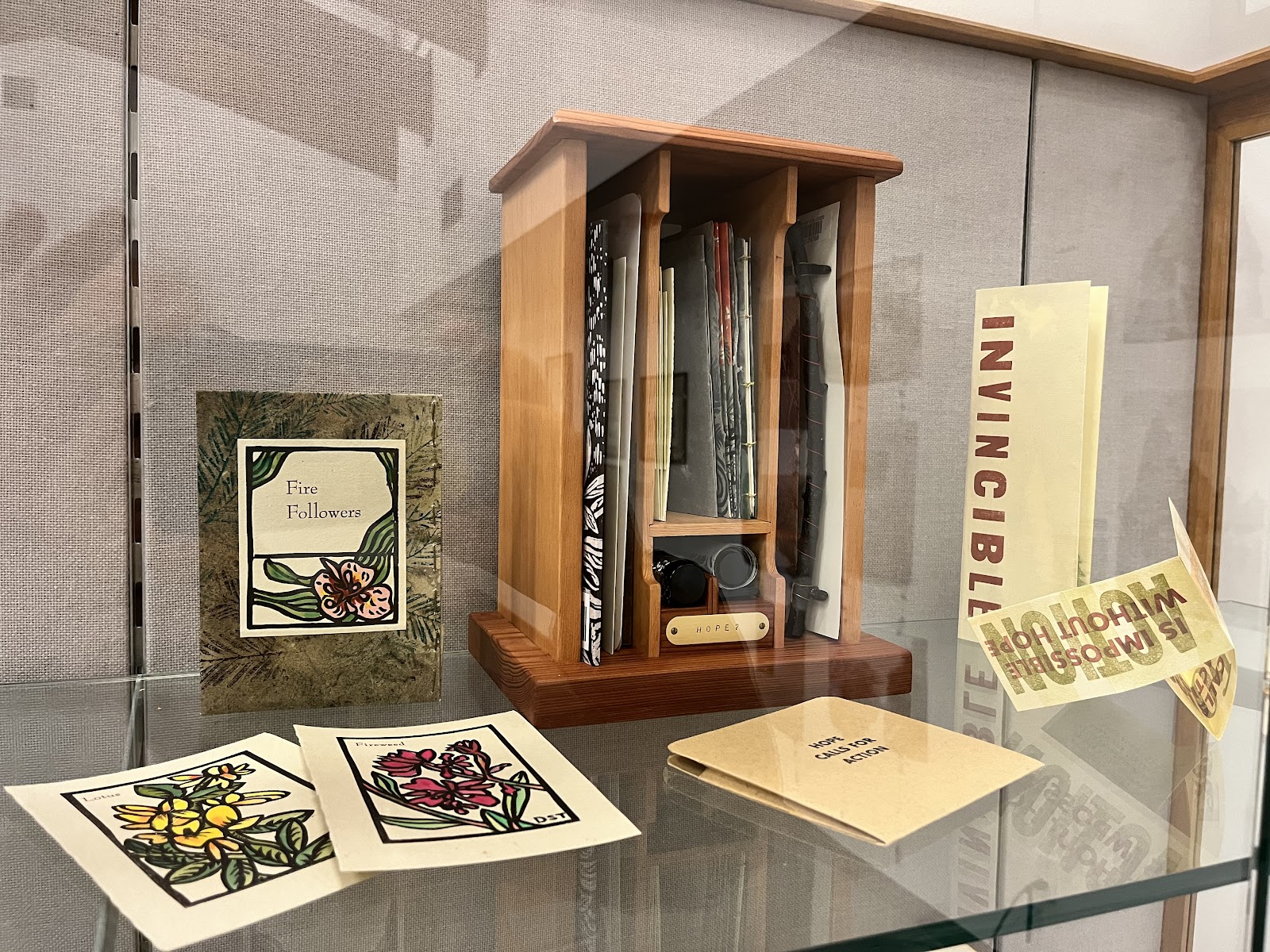On March 23, 2024 we left home, on our first trip as Wandering Book Artists since the pandemic stopped everything. The first thing we did was stop for gas, and the first thing that happened was a crowd of gas pumping patrons crowded around the wagon to get a closer look. It seems to have a magic that bridges over differences of age, ethnicity, regional differences and politics and creates a space where we get to share beauty and conversation with everyone.
As Wandering Book Artists we also have the good fortune to visit and share with librarians, art students and professors, and members of community-based book arts centers in person. We get to talk about the future of the book as art, the skills involved in making books, and show them our artists' books. Everyone learns so much as we talk about each book while they look through them, turning pages or unrolling a scroll. We can share the inspirations that drove each decision in the making of the book. We talk about how the two of us work together, how we divide tasks, and give feedback to each other's ideas. And we also get the opportunity to learn from them through the questions, statement, thoughts, and the books they show us.
First night out on the road
Our first library visit was to Scripps College in Claremont, California. We talked to a book arts class where they were getting ready to make their final book project of the semester. They analyzed book structures and printing techniques in our books. They asked good questions about the viability of making a living as a book artist.
Librarian Jennifer Wormser brought a cart of early fine press printed books, including the Kelmscott Chaucer, the Allen Press's Youth, the Grabhorn's Leaves of Grass, and these books were studied and compared to our books on display. This is Granite and Cypress, printed by William Everson, Peter's printing mentor.
A book we made titled
Hope? was in a show at the Clark Humanities Museum, curated by students at Scripps College. We received a last minute invitation to discuss what we learned making the books to a group of students, faculty and staff in the gallery.
Our next stop was Occidental College. We parked the caravan on campus right in front of the library. What a funny scene it was driving along sidewalks that were reserved (and filled with) pedestrians. While Peter talked to Jocelyn Pederson's letterpress printing class Donna stayed in the wagon watching over 75 people enter and marvel at its uniqueness and imagine the dreaminess of traveling around the country for a bit of one's life.
Touring the caravan and looking at artists' books at Occidental College
Our host librarian, Helena De Lemos shared with us that most of the students we were meeting attended their last 2 years of high school through Zoom because of the pandemic, and in contrast to the past, they clearly value and appreciate being at school, being with other students and teachers, and taking advantage of the on-campus resources.
In the print shop they set type, comparing the typographic nuances learned as apprentices: Jocelyn worked for the Robertsons at Yolo Bolly Press and Peter worked with William Everson at the Lime Kiln Press.
The Lowercase: Occidental College's letterpress shop
The Phoenix Public Library is a real showcase for a modern, beautiful, comfortable, sustainably-built library. If you get a chance, stop in for a visit. They also have a great archive of rare books which they regularly display from. Look for our Koch Real Accordion Book there!
Alex Mada, Phoenix Public Library Rare Books Room looking at our books
The next day Peter gave a short talk at a gathering of Arizona artists hosted by Karla and Jim Elling in Paradise Valley, Arizona. Before our talk Karla asked each artist to introduce themselves and describe their practice and in this way we all learned a bit from each other!
We are working on a book with seven unpublished watercolors by Maynard Dixon that he made to illustrate Walt Whitman's Leaves of Grass. One of the reasons for this trip was to learn more about Dixon and his southwest. In Tucson we met with Mark Sublette at his Medicine Man Gallery where we found a wealth of information to help us with this project
Maynard Dixon
The next stops were in Texas where we visited the library at the University of Texas, El Paso and the University of Texas, Austin, as well as teaching a class for the Austin Book Arts Center and gave an evening Book Arts Folk Song concert for the Green Man Cafe. We enjoyed a super bloom of flowers along the road between Tuscon to Austin. So many flowers. And then again as we left Austin passing Burnet where they were holding the Bluebonnet festival we saw endless miles of roadside flowers.

Texas sunset
Paintbrush, evening primrose, bluebonnet, and Indian blanket, and more!

Peter strolling into the library at University of Texas, El Paso.
There is a surprising connection between Bhutan and UTEP!

Barrel Cacti at the roadside campsite in Texas
At the University of Texas in Austin's Special Collections in the Fine Arts Library, as Peter talked about each book, the librarian, Tina Tran, told him she was impressed by his professionalism. I guess experience pays off: we've visited lots of libraries over the last 15 years as the Wandering Book Artists!
Peter taught a 2-day workshop at the Austin Book Arts Center. They explored letterpress printing techniques and simple folded paper pamphlets while jointly creating a finished book project.
On Friday evening at the Green Man Cafe we again showed our books (and Donna's road trip knitted book artists' mitts and hats) and we closed out the evening with a book arts folk song concert.
Serindiptiy: Peter meets letterpress printer Bradley Hutchinson. They both began printing the same year, 1975 Bradley at the U of Alabama and Peter at UCSC, with paralleling careers. They had corresponded but never met. One of the treats of being on the road.
And now we begin our trip back west - to California, via Santa Fe, the Grand Canyon, and Mt Carmel with Maynard Dixon's home. That story will be told in a blog post after we are home!















































